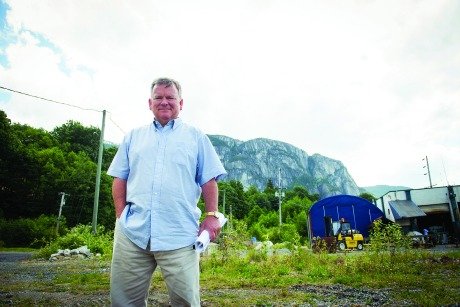
Photo: David Fournier
By Gagandeep Ghuman
Published: Sept. 5, 2014
The Scott Crescent development is finally moving ahead despite concerns by Hospital Hill residents about traffic and unsustainable density in the neighbourhood.
But the development is a positive sign for Squamish and isn’t targeted towards commuters, said John Moonen, a spokesperson for the project.
“We don’t think this will be a commuter housing hub,” said Moonen.
“Squamish is growing and people want to live and work here, there are retired people and young families looking for housing.”
Spread in 8.3 acres, the approximately 425 unit residential project will be developed in six phases, each determined by the market.
The project has been delayed several times; it’s often cited as an example of the district’s inability to be receptive to investors in Squamish.
In 2008, the Red Point development failed to get third reading, and two years later, an application to build a RV park was also rejected.
The application to rezone the property from tourist commercial to residential was put on hold by the district as it undertook an ambitious study in Upper Mamquam Blind Channel Study.
“It took four years, and everything we have done here fits that study,” Moonen said.
Moonen said the residential development is a better use for this site, compared to commercial and an industrial one.
“You can put the industrial in Business Park, but the waterfront is an appealing part of the community and people want to live here,” he said.
Kingswood had earlier planned a gym and a meeting room, but has since changed that in favour of trails and pedestrian bridge to Rose Park.
A waterfront walkway will start at Highway 99 Vehicle Bridge, and run along the waterfront, connecting with the Corridor Trail, the Valleycliffe Trail and the pedestrian bridge.
New pedestrian and bike trails are also being proposed to improve connectivity between Hospital Hill, Valleycliffe, downtown as well as improved access to Smoke Bluff Parks.
The pedestrian bridge from the property to Rose Park will connect Kingswood to downtown, he said.
The circular route, from Rose Park to Scott Crescent to the Corridor Trail, will connect more trails in the area, he added.
A community based public art project along the Highway, a kayak/canoe launch, a community meeting room, contribution towards a pedestrian underpass and improvements to Pipeline and Toboggan trail are also proposed.
On a more contentious issue of traffic, Moonen said the main access point to the development is Scott Crescent and Highway 99.
He said traffic consultants’ reports indicate that at least two-third of the morning traffic will be going north towards Squamish to drop kids off for school or further north to Whistler. Only about one-third will take to Clarke Drive.
During peak hour, this means 57 vehicle trips through the neighbourhood, or less than one vehicle trip per minute.
“There will be a waterfront park, a bride, more trails, people and a commercial area, he said.
“People have to decide if that is worth the trade-off of having one car per minute go in front of their home.”


Jon S. says
Great project!
G_h says
Allegedly there is a some strong opposition to this project, though it seems to be entirely verbalised by one person. It is hard to see how this project can be criticised to a major extent. The current site is a mess. It would be great if it could have be bought by DoS and used as waterfront parkland but realistically that’s too expensive. The benefits from the new pedestrian bridge and trail linkups are significant, especially through creating a new access to the Smoke Bluffs area. I understand a few homeowners are being impacted badly, but surely they understood the risks when they bought next to vacant private land? Road access issue seems minor … the impact from Crumpit Woods traffic when all that is complete will be greater..